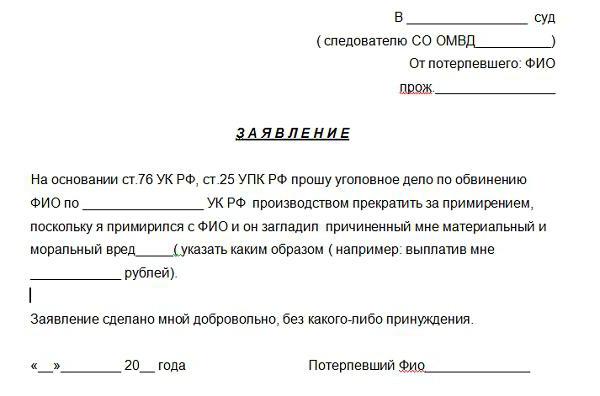The universally recognized rule of criminal law in any state is the provision that the offender must be sentenced. The effectiveness of the measures is ensured not so much by the gravity of the sanctions as by their inevitability. Meanwhile, in cases separately stipulated by law, a person may be exempted from liability. 
Termination of business
This procedure has been used in practice since ancient times. The possibility to terminate the proceedings before the trial is provided for in the laws of various states, including Russia. As an analysis of criminal practice shows, there has recently been a tendency to reduce cases in connection with their closure at the preliminary investigation stage. This procedure is carried out differently in different countries. However, its essence remains unchanged. According to lawyers, exemption from liability can be considered fair and justified only if it does not create obstacles to the protection of the freedoms and rights of the individual, the rule of law in general, while contributing to the correction of the guilty party and the prevention of new acts. Simply put, the termination of the case must comply with the objectives of the law, to ensure that the goal of punishment is achieved without its real application.
Grounds
Given the above, it can be concluded that exemption from liability is allowed in relation to persons who have committed acts of minor gravity or moderate crimes. It is worth saying that the introduction into criminal law of provisions on the categories of illegal actions brought some clarity to the solution of this issue. As Article 15 of the Code points out, reckless and deliberate crimes, for which the most severe punishment (imprisonment) is assigned for no more than 2 years, are classified as minor offenses. For moderate acts, this period is not more than 5 years. The second reason for the release of a person is a small degree of danger of the offender or its complete absence. The level of threat to society is an abstract concept (in comparison with the severity of the act). When determining it within the framework of investigative and judicial practice and criminal law science, the circumstances characterizing the person’s behavior before and after the commission of the act are taken into account. Their circle is very diverse, so a complete list of them is impossible. Together with these circumstances, the gravity and nature of the act itself are taken into account. 
Circumstances
As mentioned above, the factors that characterize the behavior of the subject before and after the crime are diverse. Some of them, however, are enshrined in law. Among them:
- Confession Turnout.
- Reconciliation of the accused with the victim.
- The commission of the act for the first time.
- Change of scenery.
- Assistance in solving the crime.
- Making amends, compensation for damage (active repentance).
The presence of one or more circumstances in combination with a small or medium severity of the act may guarantee that a citizen will recover without imposing real criminal punishment on him.
Reconciliation with the victim: Criminal Code
As a rule, in order to stop the production at the stage of the preliminary investigation, a combination of several circumstances is necessary. For example, Article 76 of the Code refers to them:
- The commission of the act for the first time.
- Elimination of harm caused to the victim.
- Reconciliation with the victim.
Meanwhile, the latter is considered as an independent circumstance, in the presence of which the case can be closed. 
Specificity of Norms
The legislator passes the decision on the issue of ways out of the situation to the victim. The victim of a crime should not assess the level of danger of the act. However, the victim may be humane if the offender takes certain measures in his favor. This approach of the legislator indicates respect for the interests of the victim. It is fully consistent with the goal of restoring justice. If the victim believes that it will be achieved, if the guilty person apologizes to him, returns the stolen item, restores the damaged property, etc., the legislator should not insist on the mandatory application of punishment to the person who committed the act.
Conditions
Within the meaning of Article 76, exemption in connection with reconciliation with the victim is allowed in the following circumstances:
- The lightness of the act.
- The presence of factors indicating the possibility of correction of the subject without criminal prosecution. These include the commission of an act for the first time, smoothing out the harm done to the victim, reconciliation with the victim.
- The inappropriateness of the intervention of the authorized bodies in case the victim is interested in ending the proceedings.

Special cases
In addition to cases of a public nature, there are proceedings that are instituted solely at the request of the victim. These include rape, violation of the author’s rights, unskilled defamation, light bodily harm. Proceedings for the last two crimes are instituted solely on the complaint of the victim. At the same time, only in connection with reconciliation with the victim. With regard to violations of the author’s rights and rape, these cases are also instituted on the basis of the victim’s complaint. However, if the investigation still took place, reconciliation with the victim in these cases is not a reason for termination of production. Such cases are dealt with in a general manner. Reconciliation with a victim in court allowed before removal to the meeting room and sentencing.
Nuance
In exceptional cases, the law allows the prosecutor to initiate proceedings without a complaint from the victim. Production materials are sent to investigators or interrogators. At the end of the preliminary investigation, the case is examined in a general manner in an authorized instance. Wherein reconciliation with the victim It is not a reason for termination of production. This rule applies even when a request has been received from the victim. 
Reconciliation with the victim: a petition for petition
It is regulated by article 9 of the Code of Criminal Procedure. To terminate the case, you must reconciliation statement by the victim. Sample the petition is filled out according to the rules provided for documents sent to the authority authorized to consider the merits and sentencing. In particular, the name of the body to which it is sent, information about itself, information about the production is indicated. Certainly reconciliation statement must be voluntary. The accused himself or through his representatives must take legal measures to redress the guilt. It was on his initiative that the reconciliation with the victim. Sample The petition contains a brief description of the intention of the perpetrator. The text, as a rule, contains remorse for the deed, sets out the measures that the subject agrees to take. If all actions have been completed, reconciliation statement. It is transferred to the prosecutor, investigator / interrogator or directly to the authority considering the case. Reconciliation request must be checked by authorized employees.First of all, it is established whether the corresponding intention was expressed voluntarily. Victim reconciliation statement acts as a confirmation of the perpetrator of lawful actions aimed at redressing the harm caused by the crime. 
Moral damage
As article 53 of the Code of Criminal Procedure indicates, the victim is a person who has been harmed by the crime. Damage can be moral, property, physical. The first can be eliminated in two ways. First of all, the perpetrator can commit certain acts of a non-property nature. For example, it may be an apology. If such actions have achieved the goal, then smoothing out the harm will be absorbed by the concept of "reconciliation with the victim. "CC in many of its articles provides for a monetary penalty as a sanction. However, acting as a punishment, fines are levied in favor of the state. Meanwhile, the perpetrator of his own free will can pay the victim compensation for non-pecuniary damage. This is the second way to smooth out the harm.
Physical damage
Such harm, as a rule, cannot be compensated for in a non-property form. In the case of physical damage, the only thing that the guilty can do is to compensate for the costs of restoring health, treatment, etc. The amount of compensation, of course, will depend on the severity of the damage. A similar situation is with property damage. It can only be compensated for by compensation. As a result, the compensation of harm under article 76 of the Criminal Code is reduced to the fulfillment of obligations regulated by Chapter 59 of the Civil Code.
Civil Code Provisions
Analyzing the legislation, we can come to the following conclusion. Under the conditions of exemption from liability in cases of committing a crime of minor gravity for the first time, it is necessary to understand, first of all, the reconciliation of the parties, and the second, the perpetrator (debtor) committing specific actions in favor of the victim to fulfill obligations arising from the harm. At the same time, the latter involve not only the payment of money, but also the transfer of some property, the performance of work, etc. If, however, the parties have obligatory legal relations, then it is impossible not to take into account other provisions of other. 1 sec 1 h. 1 Civil Code. They are also subject to application, as are the norms of the Code of Criminal Procedure and Criminal Code. The Civil Code sets forth a relatively new basis for termination of obligations. In particular, we are talking about the institution of debt forgiveness. It was regulated by pre-revolutionary law, and then it was canceled and was absent in the Civil Code of 1964. Currently, Article 415 of the Code establishes the following. The obligation shall terminate upon the release of the debtor by the creditor from him, if this does not infringe on the rights of other persons. In practice, this rule is applied as follows. The victim is reconciled with the guilty party as a result of the commission of the latter by appropriate non-property actions. As a result, the victim forgives the subject and asks to complete the production. Such a situation is quite real, especially in situations where relatives, neighbors, spouses, etc. are involved in the case. In such cases, the victim’s request is either satisfied by the competent authority (even if the harm has not been smoothed out), or recognized as not subject to satisfaction. In the latter case, accordingly, the proceedings continue. 
Explanations
The variability of the decision of the competent authorities to satisfy the request of the victim for reconciliation is determined by the fact that its adoption does not appear as an obligation, but as a right of the competent structures. Accordingly, the use of the institution of forgiveness is allowed only when the investigator, prosecutor, interrogating officer, the court considering the case, taking into account all the circumstances, come to the conclusion that the termination of the proceedings will not affect the interests of other citizens, the state or society as a whole.If there is any doubt about the favorable outcome of the implementation of this legal mechanism, then the provisions of article 76 cannot be implemented.
Effects
If in the public law plan the use of the institution of forgiveness is permissible, then there are no grounds for bringing the perpetrator to justice. The victim at the same time exercises his right granted by article 415 of the Civil Code. When applying this rule, however, the competent authorities are obliged to find out whether the victim understands the consequences of terminating the obligation by forgiveness, whether the citizen is able to realize this at all. In addition, it is necessary to establish whether the actions of the victim are voluntary. When making a decision, he should not be under mental coercion, physical pressure from the offender.
Additionally
The institution of forgiveness should be distinguished from the refusal to exercise civil law provided for in Article 9 of the Civil Code. The will of the victim, in principle, may not imply actions, the possibility of which is enshrined in article 415. A citizen has the right not to insist on the fulfillment by the guilty of the obligation and to refuse at the moment from presenting a claim for “making amends”. However, he retains this opportunity within the statute of limitations. In this situation, taking into account the will of the victim, there are also no obstacles to the application of the institution of exemption from criminal punishment. When deciding on the completion of proceedings, the authorized body is obliged to reflect in the decision the legal grounds for the fact indicating that the damage has not been smoothed out. Of particular importance is the reference to a specific norm - article 415 or 9. In the latter case, the victim retains the right to sue subsequently, but in the former it does not, since the forgiveness of debt is the basis for terminating the obligation. 
Conclusion
Thus, the reconciliation of the victim and the perpetrator (mutual expression of intent aimed at resolving the conflict caused by the criminal act) acts as a prerequisite for ending the criminal proceedings on the basis of the provisions of article 76 of the Criminal Code. At the same time, “making amends for harm” is an optional circumstance. This is due to the fact that the victim has the right to either forgive the debt (partially or completely), or refuse to exercise the right to demand compensation for damage (also partially or completely). In both cases there are no obstacles to ending the persecution. Exemption from liability as a result of reconciliation with the victim is allowed not only with partial compensation for the damage caused. This legal instrument can be used, in principle, even in the case when there was no compensation for property damage at all.